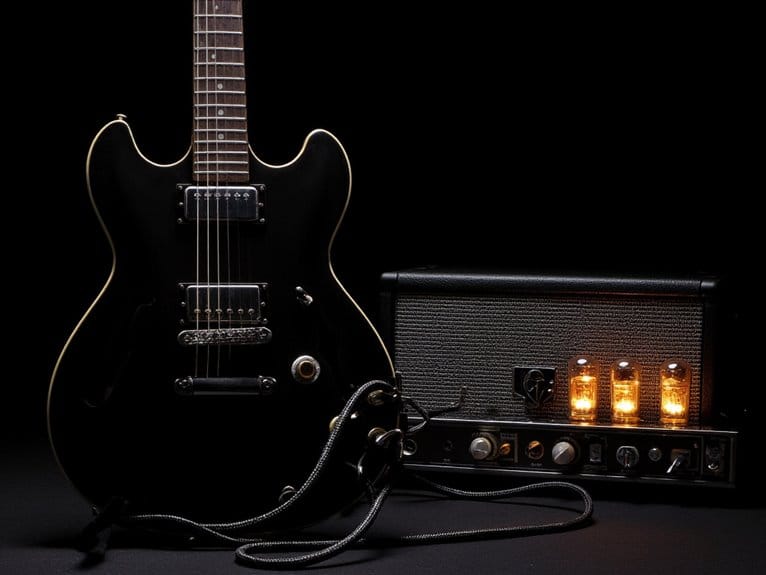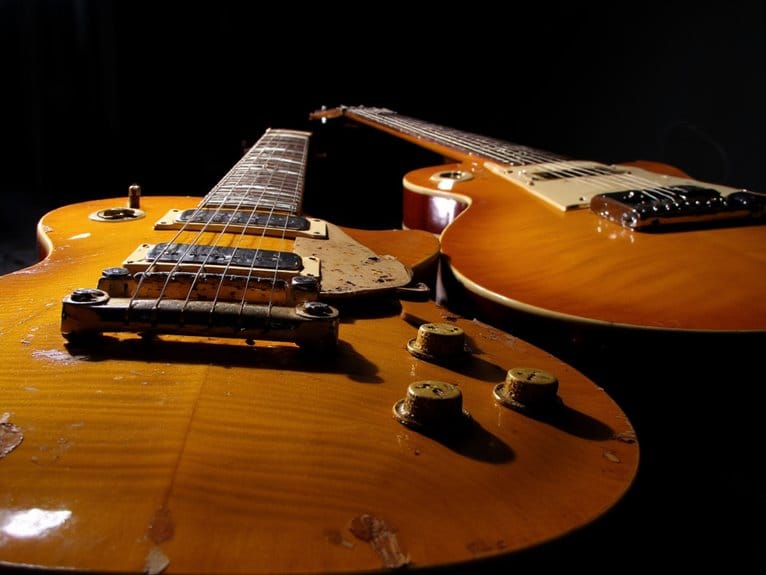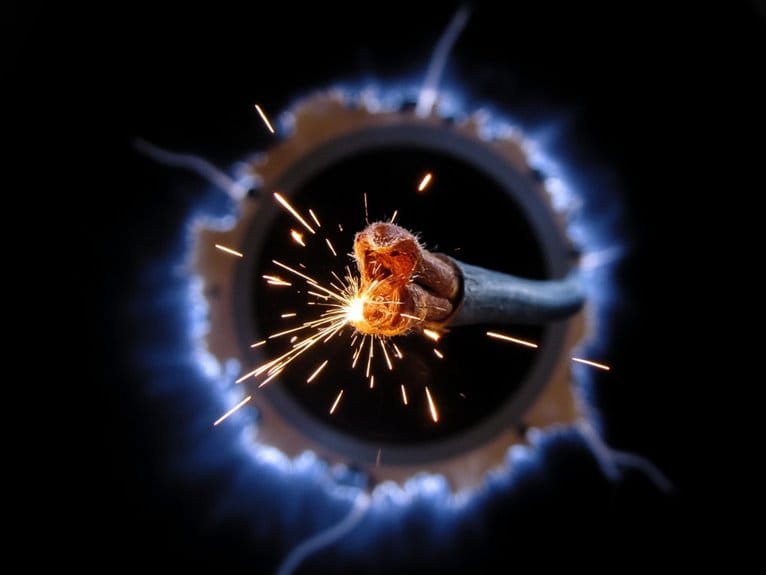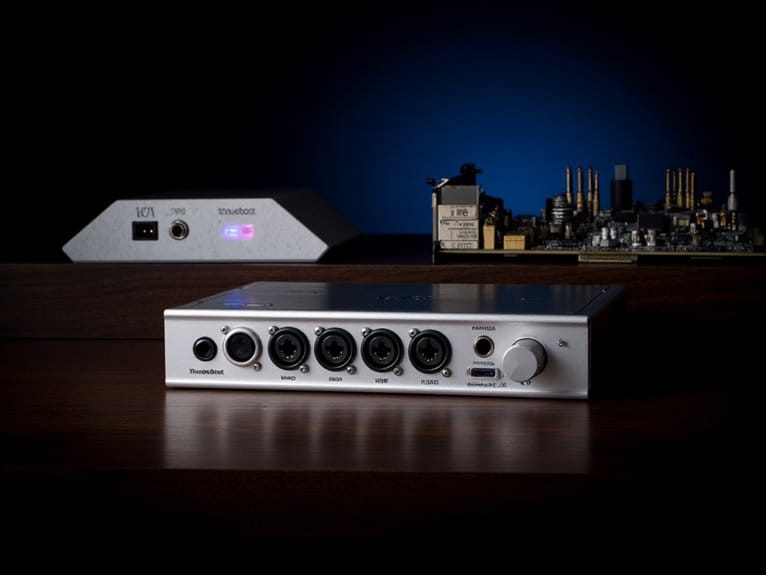Understanding Guitar Preamps and Their Role in Tone
Your guitar preamp amplifies your pickup’s weak signal to usable levels while shaping tone through frequency sculpting, harmonic enhancement, and dynamic control. Whether you choose tube preamps for their natural warmth and musical compression or solid-state versions for consistent gain and sharp transients, proper placement after your guitar but before effects pedals maximizes effectiveness. Input impedance matching—ideally 1MΩ or higher for passive pickups—preserves your guitar’s natural character and prevents signal degradation, fundamentally establishing the sonic foundation that everything else builds upon.
We are supported by our audience. When you purchase through links on our site, we may earn an affiliate commission, at no extra cost for you. Learn more.
Notable Insights
- Preamps amplify weak guitar signals to usable levels while providing tone-shaping controls and enhancing distortion characteristics.
- Tube preamps deliver natural harmonic distortion and warmth, while solid-state preamps offer consistent gain and cleaner output.
- Proper input impedance matching is crucial – passive pickups need 1MΩ or higher, piezo systems require over 10MΩ.
- Preamps should be placed after the guitar but before effects pedals to maximize signal boosting effectiveness.
- Quality preamps shape fundamental tone through frequency sculpting, harmonic enhancement, and dynamic control before effects processing.
What Guitar Preamps Do and Why They Matter
When I first started playing guitar, I’ll admit I didn’t fully grasp why preamps mattered so much, but after years of experimenting with different setups, I’ve learned that these unassuming components are absolutely vital to your sound.
Think of preamps importance as the foundation of everything you hear—they’re the first stage that takes your guitar’s naturally weak output signal and boosts it to a usable level for further processing. Without this pivotal amplification, you’d end up with thin, weak audio that lacks the punch and presence you need for professional-quality sound.
Beyond just volume boost, preamps provide signal clarity through compression and tone shaping controls, giving you the tools to sculpt your signature sound before it reaches the power amp stage. Many tube amplifiers incorporate 12AX7 tubes in their preamp sections, which provide effective compression that enhances the overall distortion characteristics of high-gain amplifiers.
Preamps also offer tube warmth and response characteristics that can transform your sound from sterile to vintage without requiring an actual tube amplifier. For acoustic guitars especially, ensuring pickup compatibility with your preamp is crucial since different pickup types like piezo, magnetic, and active pickups each require specific impedance matching for optimal performance. Modern preamps often feature 3-band EQ systems that allow for precise midrange control and frequency selection to achieve your desired tonal characteristics. Proper signal shielding in preamp circuits is crucial for maintaining the integrity of your guitar’s signal and preventing unwanted interference that could compromise your tone quality.
Types of Preamp Technologies and Their Characteristics
When you’re choosing a preamp, you’ll encounter several core technologies that fundamentally shape your guitar’s signal path, with tube and solid-state circuits representing the most traditional divide in amplification approaches.
The pedal format has democratized preamp technology, allowing you to access everything from vintage tube warmth to crystal-clear solid-state transparency in compact, pedalboard-friendly enclosures that I’ve found surprisingly versatile in both live and studio settings. Many modern preamps also function as direct boxes, converting your guitar’s high-impedance signal to low-impedance balanced output for professional audio equipment.
Input impedance design, though often overlooked by players, critically determines how your guitar’s pickups interact with the preamp circuitry, affecting everything from frequency response to signal clarity in ways that become immediately apparent once you understand the relationship. Professional guitar preamps typically provide sufficient gain structure to accommodate various pickup output levels while maintaining the clean signal paths essential for preserving tonal integrity. Professional preamps often include switchable attenuation options to handle high-output instruments while maintaining optimal signal levels throughout your entire signal chain.
Quality preamps incorporate advanced DSP capabilities to enhance signal processing and reduce unwanted noise artifacts that can compromise your guitar’s natural character.
Tube Vs Solid-State
At the heart of every preamp debate lies a fundamental choice between two distinct amplification philosophies: tube and solid-state technologies.
Tube preamps deliver that coveted tube warmth through thermionic emission, where heated cathodes create natural harmonic distortion and musical compression that guitarists have cherished for decades. You’ll notice how tubes add character and unpredictability, especially when driven hard, producing that “live” quality that makes recordings feel more organic.
Solid-state preamps, conversely, offer solid state clarity through transistor-based amplification, maintaining consistent gain without natural break-up while delivering sharper transients and brighter attack. Just as humbucking pickups provide thicker, warmer sounds with excellent noise rejection for heavier rock styles, solid-state preamps excel at delivering clean, interference-free amplification. When recording, achieving crystal-clear audio requires careful consideration of your preamp choice alongside proper microphone techniques and noise management.
While tubes require more maintenance and careful handling, solid-state designs provide reliability and cleaner output across all volume levels, making your choice largely dependent on whether you prioritize sonic character or practical consistency.
Similar to how drummers must consider bronze alloys when selecting cymbals for their tonal complexity, guitarists face material and construction choices that fundamentally shape their instrument’s sonic character.
Pedal Preamp Options
Beyond the fundamental tube versus solid-state decision, you’ll find that pedal preamps offer an incredibly diverse landscape of amplification technologies, each designed to solve specific tonal challenges or enhance particular aspects of your guitar’s natural voice.
JFET advantages include their tube-like dynamics and high input impedance, making them excellent for boost applications that preserve your instrument’s integrity.
Op amp versatility shines in complex circuits that incorporate multiple gain stages, EQ controls, and various clipping diodes for extensive tonal sculpting. These sophisticated designs often feature true bypass switching to preserve signal integrity when the preamp is disengaged from your signal chain.
Colored tones emerge from tube and console emulation pedals that add distinctive harmonic character, while clean boost designs focus on headroom expansion without sonic alteration.
Digital convenience consolidates multiple preamp emulations into single units, offering algorithmic recreations of classic analog warmth with unprecedented flexibility.
Many guitarists integrate loop pedals with their preamp setups to layer the enhanced tonal characteristics across multiple recordings, creating rich, complex arrangements that showcase the preamp’s sonic contributions.
Professional-grade preamps deliver exceptional sound quality through advanced circuit design, while 48V phantom power compatibility ensures seamless integration with condenser microphones for recording applications.
Input Impedance Design
While most guitarists focus intensely on pickup selection and amplifier choice, I’ve found that input impedance represents one of the most overlooked yet critical factors in preserving your instrument’s natural voice through the signal chain.
Your preamp’s input impedance directly affects tonal balance, with the golden rule being at least 10 times your pickup’s output impedance to avoid signal loading. Passive pickups typically require 1MΩ or higher for peak performance, while piezo systems need ultra-high impedance exceeding 10MΩ.
| Pickup Type | Required Input Impedance |
|---|---|
| Passive Magnetic | 1MΩ+ |
| Active Electronics | 50-100MΩ |
| Piezo Undersaddle | 10MΩ+ |
| Vintage Coils | 500kΩ-1MΩ |
| High-Output Humbuckers | 1MΩ+ |
Lower impedance loads your pickups heavily, rolling off highs and reducing output—sometimes useful as a tonal effect, but generally undesirable for clean reproduction. Single coil pickups excel at delivering crystal clear tones when properly matched with appropriate input impedance levels, making this consideration especially important for players seeking maximum clarity and versatility. Active preamps are preferred for low-output instruments, while passive designs excel with high-output sources, making the impedance matching even more critical for optimal tonal performance. Quality cables with oxygen-free copper conductors help maintain this impedance matching throughout your signal path, preventing degradation between your instrument and preamp input.
Signal Chain Placement and Gain Staging Fundamentals
Once you’ve decided to add a guitar preamp to your rig, understanding where it sits in your signal chain becomes essential for achieving the tone you’re after.
Position your preamp early in the signal chain, directly after your guitar but before effects pedals, allowing it to provide initial amplification and tone shaping that subsequent devices can build upon.
Place your preamp immediately after your guitar and before effects to ensure optimal signal amplification and tone foundation.
This placement maximizes the preamp’s effectiveness in boosting your guitar’s natural signal while preserving its dynamics and character. Proper gain staging at this early stage prevents noise accumulation throughout the chain, maintaining signal integrity by keeping gain levels optimized rather than cranked.
Each stage should feed the next at appropriate levels, avoiding unwanted clipping while ensuring adequate headroom for clean, controlled signal processing downstream. Modern audio interfaces with zero-latency monitoring capabilities allow you to hear your preamp’s tone in real-time without delay during recording sessions. Professional audio interfaces often feature instrument inputs specifically designed to accommodate guitars and bass, preventing clipping when recording your preamp’s output signal.
When recording your guitar signal, consider using a quality condenser microphone with phantom power to capture the nuances of your preamp’s tone shaping and amplification characteristics.
How Preamps Shape Your Guitar’s Tone and Character
Guitar preamps fundamentally transform your instrument’s voice through three primary mechanisms: frequency sculpting, harmonic enhancement, and dynamic control, each working together to shape the character that defines your unique sound.
Through precise EQ control spanning 100 Hz to 5.6 kHz, you’ll achieve ideal tonal balance by boosting mids for solo articulation while adjusting highs and lows for string clarity.
Tube-based preamps add harmonic richness and natural compression, creating that coveted warm distortion at higher output levels.
Dynamic shaping occurs through your preamp’s response to pick attack, where circuit design subtly compresses harsh transients while maintaining transparency.
This initial tone foundation establishes your core sound before effects processing, ensuring you’re building from a solid, defined platform rather than wrestling with weak, undefined signals.
Just as string gauge directly affects your guitar’s tuning stability and tonal response, your preamp choice creates the foundational character that amplifies these tonal qualities.
Practical Applications for Modern Guitarists
Modern guitarists face performance demands that would’ve seemed impossible just decades ago—switching between pristine cleans and saturated leads mid-song, adapting tone to wildly different venues, and maintaining consistent sound quality whether you’re recording in a bedroom studio or playing through a rented backline amp.
Preamps deliver the performance flexibility you need, offering multi-channel selection for instant tone switching and switchable controls for venue-specific adjustments.
In recording techniques, they’re equally valuable—transparent preamps preserve your guitar’s natural character during acoustic tracking, while variable input impedance matches your pickups perfectly.
Multi-function units consolidate effects and tone controls, reducing pedalboard complexity while maintaining professional sound quality that adapts to both live performance and studio environments. Professional recording setups benefit from dedicated preamps with ultra-low-noise characteristics that preserve signal clarity throughout the entire recording chain.
Technical Design Elements That Impact Performance
Three fundamental design principles determine whether your preamp delivers professional-grade performance or leaves you fighting against muddy tone and excessive noise.
First, gain stage design directly controls your signal’s clarity and headroom – I’ve learned that moderate initial gain prevents that harsh distortion you don’t want while maintaining clean amplification. Multiple gain stages can add harmonic richness, but they’ll also introduce more noise if poorly implemented.
Moderate initial gain prevents harsh distortion while preserving clean amplification – multiple stages add richness but risk increased noise.
Second, feedback characteristics shape your tonal response through equalization circuits, with Baxandall EQ designs providing that smooth bass, middle, and treble control you’re familiar with.
Finally, component selection between tubes, transistors, or op-amps fundamentally alters your preamp’s sonic character, noise floor, and dynamic response in ways you’ll immediately notice.
Frequently Asked Questions
Can I Use Multiple Preamp Pedals Together in My Signal Chain?
You can definitely use multiple preamp pedals together for creative tonal blending. Just watch for potential signal interference and noise buildup. Experiment with placement order to achieve unique sounds that single preamps can’t deliver.
On a final note
Now that you’ve explored the technical foundations and practical applications of guitar preamps, you’re equipped to make informed decisions about your signal chain. Whether you’re chasing vintage tube warmth, solid-state precision, or digital versatility, remember that the best preamp is the one that serves your musical goals. Don’t overthink it—trust your ears, experiment with different configurations, and let your tone evolve naturally.






